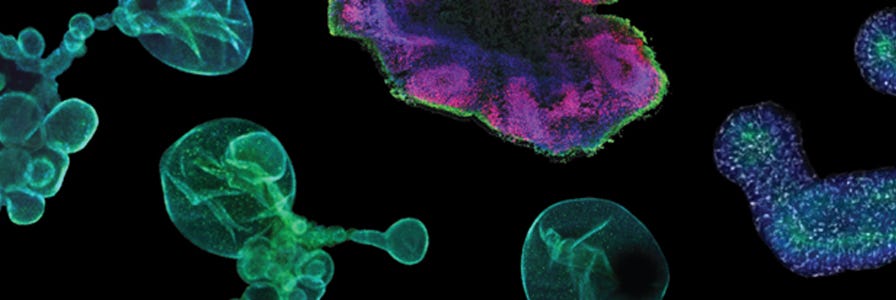A Year in Review: Our Favorite Science Stories from 2018
By Dr. Terry Thomas, STEMCELL Technologies' Chief Scientific Officer

The start of the year often brings new ideas and a fresh outlook for the future. It's also a great time to reflect upon the lessons, successes, and inspirations of the previous year. Looking back on 2018, the fields of stem cell biology, regenerative medicine, and immunotherapy continued to impress and, sometimes, shock the world with advances.
It's difficult to know where to start, but here is a selection of stories from 2018 that our scientists found the most compelling. I hope you enjoy this recap of news from our community. At STEMCELL Technologies, we are always excited to hear about the work you're doing. As Scientists Helping Scientists, we want to support you in any way we can.
Immunotherapy pioneers recognized
- James P. Allison (MD Anderson Cancer Center) and Tasuku Honjo (Kyoto University) were awarded the 2018 Nobel Prize in Physiology or Medicine. Respectively, these two researchers independently discovered the CTLA-4 and PD-1 pathways for checkpoint inhibition in immune cells, and launched cancer immunotherapy into a new era. Their pioneering work on checkpoint therapy changed the view of how cancer can be managed and has inspired promising new efforts in cancer treatment.
Thought-provoking genome editing news
Genome editing has been one of the biggest science stories of the last five years and continued to dominate the stage in 2018, driving scientific advances in virtually all areas, from basic research to the clinic. Here are just a few of last year’s stories that captured our attention:
- CRISPR continues to be the focus of genome editing research, and barriers to CRISPR-mediated genome editing of primary cells such as T cells and monocytes are starting to be overcome. These achievements bring us a step closer to engineering immune cells with the specificity necessary in the development of the next generation of immunotherapies.
- In November, Chinese researcher He Jiankui made the shocking claim that he had used CRISPR gene editing to improve the HIV resistance of twin girls born via IVF. Far from being celebrated, the news sparked an international furore, including concerns about the effects of the gene editing on other systems in the body, the potential risks of off-target effects, and the ethical ramifications of performing germline editing without serious, unmet medical need. The need for caution was underscored by a report from Allan Bradley's group (Wellcome Sanger Institute) in Nature Biotechnology showing that gene editing with CRISPR can cause extensive, unintended genetic changes at both on- and off-target sites. The big question now facing the scientific community, and society at large, is how to build the ethical and regulatory framework necessary to guide if, how, and when human germline editing is performed.
- Researchers at the Chinese Academy of Sciences, lead by Qi Zhou, Baoyang Hu, and Wei Li, successfully generated bimaternal and bipaternal mice by combining embryonic stem cells and CRISPR-Cas9 technology. The results were published in Cell Stem Cell and have wide-ranging future implications, from furthering our understanding of mammalian reproduction to addressing barriers in same-sex reproduction.
Genome editing of human primary T cells
Learn how to use CRISPR-Cas9 to genetically modify human primary T cells.
Genome editing of human pluripotent stem cells
Learn how to use CRISPR-Cas9 to genetically modify human pluripotent stem cells.
Clinical research advancements that caught our eye
- In a Nature Medicine case study, Steven Rosenberg’s lab at the National Cancer Institute reported successful treatment of a late-stage drug-resistant breast cancer patient with autologous tumor-infiltrating lymphocytes (TILs). Breast cancer treatment has traditionally relied on small molecules/anti-hormone therapy and chemotherapy—this paper represents a shift to immunotherapy approaches.
- There were several other advances in cancer immunotherapy, including promising preclinical and clinical trials for using CAR-T cells to treat multiple myeloma. Cellectis has several preclinical and clinical trials in place for their “off-the-shelf" universal CAR-T cell (UCART) products for treating various cancers. City of Hope researchers launched a new Phase I trial for CAR T cell treatment of glioblastomas and have several other plans for CAR-T research in various other solid tumors. Progress is also being seen with CAR-NK cell research, including a second Phase I/II clinical trial approved at the University of Texas MD Anderson Cancer Center.
- Results from a Phase I clinical trial showed promising results for regenerative medicine for retinal diseases. Researchers with The London Project to Cure Blindness reported in Nature Biotech that patients with age-related macular degeneration regained their vision after receiving retinal tissue engineered from human ES and iPS cells.
CAR T cell wallchart
Get a free Nature Protocols wallchart summarizing the CAR T cell manufacturing process.
Brief review of CAR T cell research
Explore our selection of key advancements in CAR T cell therapy research.
At the frontier of basic science research
- Organoids continue to be a source of rapid and intriguing advancement. Here are just a few examples from 2018: It was demonstrated that human breast and gastrointestinal tumor-derived organoids have the same genetic mutation profiles and drug sensitivities as the parental tumors. Importantly, these findings support the use of patient-derived organoids in guiding personalized medicine. The potential for using organoids to study early brain development and associated disorders, such as epilepsy or autism, was demonstrated by work from Alysson Muotri’s lab at UCSD showing that brain organoids can produce electrical patterns (EEG) that resemble fetal human brains. Finally, Madeline Lancaster and Sergiu Pașca have each shared early reports demonstrating that brain organoids and muscle cells can be combined to model neuromuscular junctions and motoneuron diseases.
- Recognition of the importance of the neuro-gut axis continued to grow, with a key study from Viviane Labrie’s lab at the Van Andel Research Institute showing that removing the appendix early in life reduces the risk of developing Parkinson’s disease by 19-25%. The appendix acts as a major reservoir for abnormally folded alpha-synuclein proteins. Additionally, 2018 saw increasing interest in the role of microglia and neuro-immune communication in neurodegenerative diseases such as Alzheimer’s and Parkinson’s Diseases.
Cerebral organoids webinar
Dr. Madeline Lancaster discusses her groundbreaking work in the development of cerebral organoid technologies.
Organoid resource center
Explore information on organoid cultures and applications, including webinars, publication lists, researcher profiles, and more.
And a memorable neuroscience finding...
- The standard theory of memory has been challenged with a report from Dr. David Glanzman’s group at the University of California, Los Angeles that memory of long-term sensitization in snails can be transferred via RNA to untrained snails. The findings support an epigenetic model of memory storage, at least in snails, and raises the (still far-off) possibility of new treatments for memory loss.
If you’re interested in learning about more science that we find inspiring, be sure to visit our Celebration of Science page, where we shine the spotlight on the scientists—and their breakthroughs—that inspire and motivate us.






